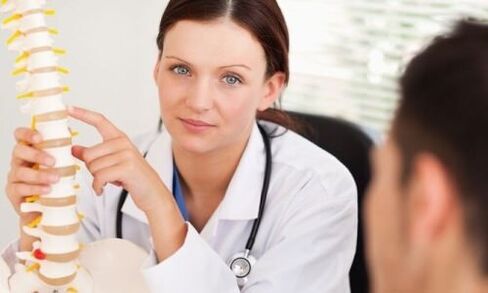The development of information technology and the computerization of the population have turned the table into a place where a person spends almost the whole day in this position. The unpleasant painful sensation in the spine is known to almost every second person. Pain in the spine, limbs, numbness in the legs are the main signs of osteochondrosis. In addition, if earlier people over 40 suffered from osteochondrosis, today teenagers are already faced with this disease in high school.

According to localization, osteochondrosis is divided into several types - cervical, thoracic and lumbar. One of the most common types of disease is called cervical osteochondrosis. It must be said that due to its localization, it provokes complications in the work of the brain, full of neurological diseases. From our article you will learn in detail about this disease, its course, features of treatment and prevention.
Causes of cervical osteochondrosis
Maybe it sounds a little strange, but the cause of osteochondrosis of the spine is. . . . human life. Any excessive load on the spine leads to a certain deformation, due to which the disease occurs. Osteochondrosis can be prevented, cured, but only if it is not flowing. And for those who, fortunately, do not suffer from pain, I would like to warn: analyze the degree of load on the spine - and you will find out if you are at risk of osteochondrosis.
So, the main and most common cause of osteochondrosis in adults can be work that consists in constant lifting of heavy objects, such as the work of loaders. Also, the disease can be provoked by "sedentary" work in the office or work "on the feet", such as salespeople who are in a certain position for a long time, creating a load on the same muscles, sections of the spine.
There is a risk of osteochondrosis in athletes due to heavy loads or, conversely, due to a poor level of physical development in those who do not play sports at all. There are cases of the appearance of the disease even when athletes were actively engaged in training and then suddenly stopped it abruptly. It is impossible not to mention the injuries of the spine, which subsequently lead to osteochondrosis. It can affect the spine and flat feet, when due to the incorrect shape of the foot, the load on the vertebrae and discs is distributed differently, creating discomfort.

Perhaps osteochondrosis in pregnant women due to the same increased load, as in women who constantly walk in heels, overloading the spine.
The causes of osteochondrosis in the neck area can be genetic or hereditary.
Diseases of the spine can appear due to impaired metabolism in the body, obesity, low immunity, poisoning, infectious diseases that reduce the functionality of the spine.
Over the years, the spine becomes more fragile, loses the elasticity of the discs, bone density and deforms. Age is another cause of osteochondrosis.
Finally, the impact on the backbone of the environment and living conditions cannot be dismissed. Bad ecology, stress, nutrition that is not rich in vitamins and trace elements - all this can provoke the development of cervical osteochondrosis. The symptoms of osteochondrosis of the cervical vertebrae are quite pronounced. They must be known in order to stop the development of the disease in time. After all, each of us is partly at risk.
Symptoms and stages of the disease
You can recognize osteochondrosis by a simple exercise - turning the head. Painful sensations when turning are the first signs of cervical osteochondrosis. The following symptoms are muscle spasms, difficulty moving, numbness in the fingers, pain in the shoulders.
This type of disease is called radicular syndrome or cervical sciatica. This happens if the nerve roots are compressed by the vertebrae due to a violation of their location, the appearance of a hernia. The pain in this case descends in waves from the shoulder to the fingers, numbness is felt in the fingers and forearm. If the little finger and the ring finger go numb, it means that the brachial nerve is affected, this is the area of the 7-8 vertebra. If the other three fingers - the problem is in the area of the 5-6-7 vertebra, the central nerve is affected.
In addition, the disease has symptoms related to the functioning of the brain. Often the recurring headache with cervical osteochondrosis is severe or painful. Perhaps dizziness with cervical osteochondrosis, tinnitus, spots before the eyes, blurred vision, hearing, dental problems. These signs of the disease indicate that there is an effect on the two vertebral arteries that carry blood to the brain. In particular, in those areas that are responsible for blood pressure, in the cerebellar area, which controls our vestibular apparatus. This type of disease is called vertebral artery syndrome and is very common. Osteochondrosis of the cervical spine, affecting the arteries, is fraught with a violation of the ability to move normally and even strokes.
There are also irritative-reflex syndromes. In this case of cervical osteochondrosis, the symptoms are similar to those of other types of disease, but the pain attacks appear suddenly after a state of rest. For example, when a person wakes up after sleep, he feels a strong dull pain in the neck.
Another type of disease is very similar to heart disease - angina pectoris, when the pain appears in the chest and radiates to the shoulder, lasting several hours. It's a heart syndrome. A cardiogram will help distinguish osteochondrosis from heart disease, which will confirm that blood circulation is not impaired and the patient is worried about the spine, not the heart.
Osteochondrosis of the cervical spine is divided into stages of the course of the disease. At the first or preclinical stage, there is a slight change inside at the level of biochemistry. A person experiences some discomfort during a long stay in one position, during physical exertion. The muscles of the back and neck tire quickly.
The second stage of the disease is called the stage of increasing changes in the nucleus pulposus. At that time, the intervertebral disc is deformed, metabolism is disturbed in the nucleus pulposus, some of its cells die. Due to these processes, the distance between the vertebrae decreases, which subsequently leads to pinching of the nerves and spasms. A person experiences pain in the areas of damage to the spine.
In the third stage of the disease, complete or partial destruction of the fibrous ring occurs. Cracks appear through which the nucleus pulposus exits, disrupting the density of the connection of the vertebrae. The spine becomes abnormally mobile, the vertebral bodies shift. This causes a person pain in the entire back, movement disorders occur, the sensitivity of the limbs disappears.
And the most severe, the fourth stage of osteochondrosis, is manifested by regeneration of the spinal discs, the so-called fusion of the vertebrae. The nucleus pulposus replaces the cartilage, the pain subsides and the spine works as a support again. But, unfortunately, the consequence of such changes in the spine is the limitation of human mobility and even disability.
The spine has three important functions in the human body. These are support, protection of the spinal cord and cushioning during movement. Our ability to move comfortably and exist depends on the spine. Back pain should not be seen as a temporary and random phenomenon. Take it as a rule: if you feel pain with a smooth rotation of the head, you should contact a neurologist.
Osteochondrosis in children
Osteochondrosis in children is not as common as in adults, but rather a congenital or hereditary disease. But since the deformation of the spine can lead to bad consequences and cause great harm to the development of the child's body, we decided to highlight this topic separately and direct the attention of parents to osteochondrosis in children.
A child's spine is more sensitive to injury, freezing, lack of nutrients for formation and development. And this, as already mentioned, is the cause of osteochondrosis. That is why it is important to pay attention to the child's nutrition, remember that it should be rich in calcium and other trace elements, be varied and useful. In case of injuries and falls on the back, especially at a young age, consultation with a doctor is imperative for an examination and, if the disease is confirmed, possible further treatment. By the way, osteochondrosis in a child can be a consequence of birth trauma.

Osteochondrosis occurs in children and due to heredity, when the fragility of the vertebrae is transmitted genetically. If in a disease of the spine in children, the growth zone of the bone is affected, that is, the area in which the bone grows, this can also lead to impaired growth and overall development of the child. The symptoms of osteochondrosis in children are similar to those in adults, but the pain is more moderate, movements are not impaired. With cervical osteochondrosis, seizures, vertigo are likely.
If the child has prerequisites for osteochondrosis or you suspect back problems, seek medical help immediately. The earlier the disease is detected, the sooner you can rid the child of it.
Diagnosis of osteochondrosis of the cervical vertebrae
The diagnosis of cervical osteochondrosis, like other diseases, begins with an examination by a doctor. In this case, a neurologist. The doctor examines the patient in different positions - standing, sitting, lying down, examines the condition of the spine during movement. Pays attention to the posture, the location of the middle groove of the back, the position of the shoulder blades, the shoulders. In addition to a visual inspection, a tactile inspection is also mandatory. The location of the lesion is detected, guided by complaints, examination, and also with the help of a special technique for counting the vertebrae. In addition, the patient is prescribed X-ray or magnetic resonance therapy to examine the spine more carefully to determine the stage of the lesion. After diagnosis, treatment of osteochondrosis of the cervical spine is prescribed.
Treatment
Treatment of cervical osteochondrosis is usually complex. Most often it is based on several mandatory points. One of the main ones is the correct engine mode. Correct means to move without shaking your head. Any quick movements are not good for the vertebrae. Most likely, the doctor will prescribe wearing a special soft medical collar that will immobilize the neck during the treatment.
Wanting to look at something from the side of him, the patient should slowly turn his head. If you feel uncomfortable in your neck, do special exercises, get a massage.

Medicines are a mandatory stage in the treatment of osteochondrosis in the acute stage. The doctor will prescribe non-steroidal anti-inflammatory pills to eliminate the foci of inflammation and swelling. Do not forget to help relieve the course of the disease analgesics. If osteochondrosis provokes muscle spasm, then a drug that relieves spasms and relieves pain is also prescribed. Vitamin B, which improves brain function, helps fight stress and strengthens muscles, will also be prescribed. And if the patient is depressed, then antidepressants will be prescribed.
You cannot do without treatment of osteochondrosis without external preparations - gels, ointments, creams. Known anti-inflammatory drugs will act directly on the focus of the disease. There are ointments that are called chondroprotectors, that is, ointments with elements that restore the cartilage tissue of the intervertebral discs. And, of course, the patient will need ointments or creams for therapeutic massage, which is also indispensable.
Manual therapy for osteochondrosis
Many patients with osteochondrosis seek help from chiropractors. This method of treatment can be included in the complex if the patient has anatomical changes in the spine, the appearance of a hernia or displacement of discs. With the right treatment, it really gives positive results. But when looking for a specialist, be careful. Before agreeing to treatment, make sure that the specialist has a medical education and practices traditional healing, as well as that he has undergone additional training in the specialties of neurology and chiropractor and has confirming certificates. The experience of the operator is also important. After all, the therapy itself requires clear movements and, if used incorrectly, is fraught with injuries. The principle of manual therapy is point impact on the structural components of the spine. With a quick push, the joint displaced from the correct position is returned to it again. Correct therapy is undoubtedly a very effective treatment for osteochondrosis of the cervical spine.
Physiotherapy
Therapeutic exercises for cervical osteochondrosis will allow you to fight the disease even at work. In addition, simple exercises will be an excellent prevention of spinal diseases.
So, take your eyes off the screen, lean back in your chair and learn some useful exercises.
Sitting in a chair, place your feet shoulder-width apart. Relax, put your hands down. Slowly lower your head down until your chin touches your chest. If it doesn't work, it's okay, reduce it as much as possible, as much as possible. Then slowly raise your head and tilt it back, also until it stops. Returning to the starting position with an upright head, repeat the exercise 5 times.
Without getting up from the chair, slightly turn your head to the side. First in one direction, then return to the starting position and turn in the other direction. 5 times each.
Turning your head, you can go to the slopes. The exercise is also done in a sitting position, slowly tilting the head to the left, then back and then to the right. They bend their heads all the way down, trying to press their ears against their shoulders. The exercise is performed at least 5 times for each side.
This will help stretch the neck muscles and the next exercise. In a sitting position, the head is slowly thrown back, hold this position for a few seconds and slowly begin to rotate the head, without lifting it, to the left, then to the right, making a total of at least 10 rotations.
You can also, without leaving the workplace, do an exercise to warm up the shoulder muscles. Sitting in a relaxed position, start rolling your shoulders forward 5 times, then back 5 times. Do this slowly and carefully, feeling each muscle.
It will help you stretch your shoulders and the exercise known to everyone from kindergarten. It can be performed at will - sitting or standing, as the situation allows. You slowly transfer your left hand over your shoulder to your right side, touch your ear with your fingers and lower it. Throw your right arm in the same way over the head next to the left ear.
Now a little more warm-up for the neck muscles. Place your palm on your forehead, begin to press your forehead against your palm, resisting with your hand. Hold this position with a tense neck and count to 5. Then relax and repeat the exercise twice.
The exercise is similar to the previous one. But now other cervical muscles will work. You throw your hand or, more conveniently, both, folded in a lock, behind your head, put them on the back of your head and begin to push your head on your hands. Perform the exercise 3 times for 5 seconds.
Now we stretch the lateral muscles of the neck. There is only one scheme - the head pushes the hand, the hand resists. You put your left hand on the left temple, press, counting to 5, rest for a few seconds and repeat 2 more times. In the same way, the exercise is done for the right side of the neck.
Finally, a little standing warm-up. It is better to choose a free place in the office for this. Feet are shoulder width apart for better balance. With outstretched arms in a free state, they begin to rotate synchronously 5 times forward, then 5 times backward.

After a short break of 10-15 minutes, you will feel that the tension in the muscles of the back and neck decreases, let your eyes rest from the monitor, relax a little. Such breaks at work are useful, and in many modern offices they even practice a mass exit of colleagues to warm up. Do not ignore the simple rule - warm up whenever you are tired and tense. Gymnastics for cervical osteochondrosis is an excellent treatment for the initial stages of the disease and effective prevention. In more serious cases of the disease, a course of training therapy (physiotherapeutic exercises) is prescribed.
Therapeutic gymnastics for cervical osteochondrosis
Exercise therapy for cervical osteochondrosis is simply irreplaceable. A set of exercises will improve the functionality of the spine, help maintain muscle tone and relieve tension. The exercises will require some free time and a warm exercise mat on the floor. They can be done at home in the evening or in the morning before work. Of course, it is advisable to do this between meals.

Lie on your back on the floor, stretch your arms along your torso. Look ahead and begin to gradually look to the right and left, 4 times in each direction. After moving your eyes to the side, start looking up and down also 4 times. After completing the lateral warm-up, switch to rotating the eyes immediately clockwise, then counterclockwise.
In the same position, lying down, turn your head in turn in different directions. Gradually, slowly. After making 4 rotations in each direction, continue to tilt your head to the left and to the right shoulder.
You can do head lifting exercises. Also, lying on a flat surface, lift your head off the floor and tilt it towards your chest, trying to touch your chest with your chin. Pull your head as close as possible. All this without sudden movements no more than 4 times.
When performing exercises for cervical osteochondrosis, you should remember that not only the cervical region, but also the whole body requires warming up. Therefore, lying on your back, completing the first simple exercises, after warming up, proceed to the next. Open your arms to your sides and turn to the side, trying to touch the opposite side with your hand and foot, but not to roll over on your stomach. The reversal is done when inhaling, and when exhaling they return to their original position. Do no more than 5 spins.
The next exercise is to sit up from a lying position. Lying on the floor with your arms extended along your body, you need to slowly rise up, leaning on your hands. A rather difficult exercise for osteochondrosis, so once again we emphasize that you should do it carefully and slowly, 3-4 times.
Lie on your back, bend your legs and press them to your stomach, grab your knees with your hands. Then gently pull your head toward your feet and touch your knees. Also - also carefully return to the lying position. The exercise is done up to 5 times.
You are lying down, legs bent at the knees at the level of the abdomen, arms spread. Rotate your body alternately right and left up to 5 times in each direction.
Do not interfere with abdominal exercises. Turn around and stretch your arms along your body. Begin to lift your head off the floor, then your shoulders, torso, focusing on your legs and hips. Then return to the starting position and do the exercise up to 5 times.
Breathing exercises are useful for osteochondrosis of the cervical region. After a little rest from the previous exercises, lie on your back, fold both hands on your stomach. Inhale deeply and slowly, blowing out the stomach, also exhale carefully, pulling the stomach in. Take 5 inhalations and exhalations.
Place one hand on your stomach and the other on your chest. Take a shallow breath, tense your muscles, exhale, relax. The number of breaths is also 5.
These exercises are only introductory and should not be considered a complete treatment. Rather, these are recommendations to prevent the disease or its development. Therapeutic exercises for cervical osteochondrosis are selected by the doctor based on the needs of the patient.
Private massage
Massage is one of the necessary and pleasant procedures in the treatment of cervical osteochondrosis and is prescribed by a doctor. Of course, there is no question of trying to repeat a professional massage at home with the participation of relatives, this issue is really only dealt with by health workers. But you can do light kneading movements yourself, distracting yourself in the middle of the work day and relieving stress. By the way, massage will be a good addition to gymnastics.

So, feeling pain in the neck, lean back in your chair, relax your back. The massage begins with stroking the neck with palms from top to bottom, that is, from the hair to the shoulders. After stroking, turn your palms with the edge towards the neck and move your hand up and down several times, applying light pressure. Then start grinding. Place your palms on the back of your head so that your fingers meet in the middle of the spine. Rub the body, moving your hands from the center of the spine to the sides of the neck, going from top to bottom. You can massage your neck with your fingertips, rubbing it in circular motions. Then start pinching the skin and muscles by grasping them between your index finger and thumb. And then stroke your neck with your palms, completing the massage.
Self-massage for cervical osteochondrosis will help relieve pain and muscle tension.
Treatment with folk remedies
The most popular folk remedies for the treatment of any disease are herbal preparations. Treatment of cervical osteochondrosis with folk remedies is possible, as a rule, in the initial stages of the disease. Herbs such as mint, St. John's wort, calendula, yarrow, licorice root, chamomile, birch and strawberry leaves help well in the fight against diseases of the musculoskeletal system. Brew teas from these herbs, drink regularly, as a tonic and a means of prevention.
You can also take herbal baths. At least 300 grams of dry plants are needed for each bath. The pine bath helps a lot. The needles of conifers are ground, poured with boiled water and boiled for 20 minutes. Then it is filtered, added to a hot bath and steamed in it for half an hour.
You can and should make baths from chamomile, which has an anti-inflammatory effect and perfectly heals the body. Chamomile is poured with boiling water, insisted for up to an hour, filtered and added to the water.
A quick compress from improvised means will help relieve back pain. Everyone has potatoes and honey in the house. Folk methods are recommended to make such a compress from them: the vegetables are grated and mixed with honey in a ratio of 1: 1. The composition is applied to gauze and applied to the sore spot. Relief is guaranteed, but, alas, not for long.
Ginger and garlic ointment works in much the same way. They are rubbed on a grater and mixed 1: 1, a little oil or vaseline is added so that it can be smeared, and the sore spot is smeared. It will also relieve pain and inflammation, but will not cure the disease. With osteochondrosis, a mandatory visit to a neurologist is required, who will prescribe full treatment.
Finally, I would like to talk about the basic rules of behavior in osteochondrosis. Above all, keep your back straight and your head straight. Adjust your workspace to these standards by placing a book under your monitor if it's low, or find a chair that's taller.
Don't lift heavy things unless absolutely necessary. And if you really have to carry the load, take the heavy one not in a bent over position, but do it like a weightlifter with a barbell - sit down and then stand up with a weight.
Do not overcool your back, keep it from drafts. A large selection of fashionable and stylish cardigans will warm your back at any time of the year and in any circumstances.
Move more, do swimming, gymnastics, hang on the horizontal bar.
After you have mastered all the secrets of gymnastics, self-massage and the prevention of osteochondrosis with folk remedies, share them with your friends in the office. So you can not only insure yourself against spine diseases, but also help your colleagues avoid back pain and increased fatigue. Be healthy!

























